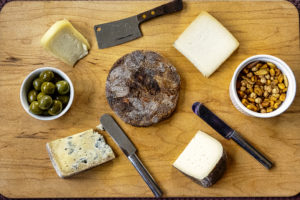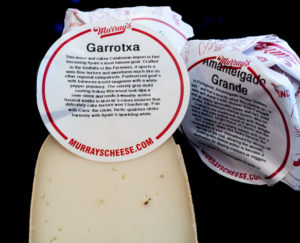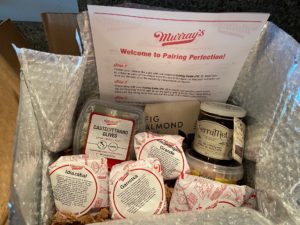Exploring the Regional Cheeses of Spain
by Bill Babash, Vice Chargé de Presse

The Bailliage of Greater Washington, DC, journeyed to Spain for an evening of cheese, wine, and camaraderie during an on-line event on March 19, 2021. Certified Cheese Professional Michaela Weitzer of Murray’s Cheese in New York led the fun and educational session. Michaela’s June 2020 on-line event for the baillage – an exploration of French cheeses – was extremely well received and the bailliage was eager to venture to a new destination with her.
Bailli Judy Mazza opened the evening by welcoming members and guests around the Washington region as well as participants in Texas, South Florida, Baltimore, and the Tidewater area of Virginia. She gave special thanks to Vice Chargé des Missions Rey Villarreal who had flawlessly handled the logistics of shipping the wine to each participant. She welcomed Michaela back and turned the evening over to her to begin the delicious class.

Michaela reminded attendees of some cheese basics – that artisanal cheese, despite its innumerable variations, is all made from only four ingredients: milk, cultures (selected bacteria strains), rennet (enzymes that coagulate the milk into curds and whey), and salt. As she began the tasting, she encouraged participants to first smell the cheese, then taste it alone, and finally taste it with the accompaniments that she had selected for each, much as one would approach a wine.

The Spanish journey began with a side-trip to Portugal and the Amanteigad Grande, a 100% raw sheep milk cheese. Michaela noted that 95% of the cheese from Spain and Portugal is sheep or goat, with sheep being the highest in fat and the nuttiest in flavor. She explained that it is unusual for a soft cheese such as this one to be made from unpasteurized milk, but two months of aging makes it safe. She asked participants to smell the cheese, prompting descriptions that included “sweetness,” “nutty,” and “tangy like yogurt.” Interestingly, though, this cheese does not taste like it smells, instead offering, according to Murray’s, a “bright flavor of lanolin and the savory essence of a hearty salami with just a hint of brine.” While most cheese is made with animal-derived rennet, the Amanteigad Grande is made with rennet produced from wild thistle. This rennet, fairly common in Spain and Portugal, imparts subtle floral notes that were amplified by a drizzle of the Portuguese honey that Michaela had selected to accompany this fascinating cheese.

Next was Idiazába, produced in the Basque region of Spain from the raw milk of the Laxta and Carranza breeds of sheep, which are known for their particularly fatty milk. It is cold smoked, reflecting its history of having been dried by a fire, and indeed, the first smell of this cheese is smokey and reminiscent of a campfire. It is aged for three months, but retains a creamy, melting mouth feel. It is made in the same style as the more well-known Manchego – lightly pressed to drain excess moisture and knit the curds together. To accompany this cheese, Michaela chose salty Spanish nuts; the crunch and salt brought out nuanced flavors of the cheese that were hiding behind the smoke. In response to a question, she confirmed that this cheese melts beautifully, making it a wonderful addition to omelets, onion soup, or even a grilled cheese sandwich. She also pointed out to participants that this cheese may be “sweating” on their cheeseboards. This is expected and not at all a problem; it simply fat coming to the surface as the cheese warms.

The evening’s third cheese was Garrotxa (pronounced ‘ga-ROCH-ah’), a semi-firm goat milk cheese from the foothills of the Pyrenees in Catalonia. With hints of sourdough bread in its aroma, this cheese strikes a delicate balance between butteriness and acidity. It does not have the barnyard flavors typical in goat milk and its acidity prompts some salivation, enabling it to go great with wine as palate cleanser. The cheese is aged for two months but has the complexity of a cheese aged for six. Aging occurs in damp caves where the cheese develops a coating of velvety grey mold. Michaela reminded everyone of Murray’s saying, “All rind is edible, but not all are palatable.” Indeed, the rind the Garrotxa is safe to eat but has the flavor of wet earth (or as Michaela candidly described it, “wet dog”). Garrotxa almost went extinct in 1980 when no one was making it any longer and the recipe was nearly lost. Fortunately, some young cheesemakers restarted production in 1984, and today it is one of the most famous goat cheeses from Spain. To accompany this delicious cheese, Michaela chose Castelvetrano olives. Unlike most salty olives, these are sweet and buttery and brought out the comparable characteristics of the cheese.

The final cheese was Pria Azul from Asturias along Spain’s northern coast. One of the mildest Spanish blue cheese, it is made with a blend of 50% cow, 40% sheep and 10% goat’s milk. Cow’s milk is uncommon in Spanish cheeses, and a mix of all three is particularly unusual. The result is a beautifully rounded cheese featuring acidity from goat, nuttiness from sheep, and butteriness from cow. As with all blue cheeses, the wheels of fresh cheese are pierced to invoke the bluing, but this variety is also smoked to impart a subtle smoky flavor. Aging then creates a gorgeous natural rind. Michaela paired the Pria Azul with a very traditional Spanish fig and almond cake; its texture, sweetness and nuttiness were superb complements to the mild blue. Michaela noted that this cheese also has a subtle gaminess that, along with the smokiness, allows it to pair well with meat. Participants asked about the strength of the blue and Michaela explained that that is determined by the number of piercings in the wheel and the specific culture used.
Vice Échanson Ellen Kirsh had the challenge of selecting a wine to go with the evening’s four diverse cheeses and her choice of the 2015 Bodegas Caudalía Garnacha Xi’ipal La Abejera hit the mark beautifully. Located in the Navarra region of northern Spain, Bodegas Caudalíahas includes 21 acres of 12- to 40-year-old vines of tempranillo, garnacha, syrah and graciano, all produced organically. This wine is 100% garnacha (aka grenache), which is indigenous to Spain. The Navarra region’s hot, dry climate results in wines with higher alcohol content – 15% for this particular wine. It is fermented in cement tanks and aged in large format (400-500 liter) used French oak barrels, resulting in minimal oak notes. It boasts lots of red fruit flavors, limited tannin, and low acidity – characteristics that enable it to go in many directions when paired with cheese and other food.

Although the cheese tasting concluded, the conversation did not, as members and guests caught up with each other and reflected on the delicious and informative evening.

































